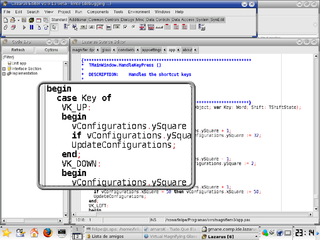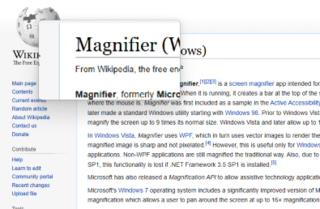Release history
Version 11 was released in 2017.
Version 2018 was released early 2018.
Version 2019 was released in late 2018.
Version 2020 was released in late 2019.
Version 2021 was released in late 2020.
Version 2022 was released in late 2021.
Version 2023 was released in late 2022.
Updates on current release versions are now published between 4 and 6 weeks apart.

Assistive technology (AT) is a term for assistive, adaptive, and rehabilitative devices for people with disabilities and the elderly. Disabled people often have difficulty performing activities of daily living (ADLs) independently, or even with assistance. ADLs are self-care activities that include toileting, mobility (ambulation), eating, bathing, dressing, grooming, and personal device care. Assistive technology can ameliorate the effects of disabilities that limit the ability to perform ADLs. Assistive technology promotes greater independence by enabling people to perform tasks they were formerly unable to accomplish, or had great difficulty accomplishing, by providing enhancements to, or changing methods of interacting with, the technology needed to accomplish such tasks. For example, wheelchairs provide independent mobility for those who cannot walk, while assistive eating devices can enable people who cannot feed themselves to do so. Due to assistive technology, disabled people have an opportunity of a more positive and easygoing lifestyle, with an increase in "social participation," "security and control," and a greater chance to "reduce institutional costs without significantly increasing household expenses." In schools, assistive technology can be critical in allowing students with disabilities access the general education curriculum. Students who experience challenges writing or keyboarding, for example, can use voice recognition software instead. Assistive technologies assist people who are recovering from strokes and people who have abstained injuries that effect their daily tasks.
Computer accessibility refers to the accessibility of a computer system to all people, regardless of disability type or severity of impairment. The term accessibility is most often used in reference to specialized hardware or software, or a combination of both, designed to enable the use of a computer by a person with a disability or impairment. Computer accessibility often has direct positive effects on people with disabilities.

A screen reader is a form of assistive technology (AT) that renders text and image content as speech or braille output. Screen readers are essential to people who are blind, and are useful to people who are visually impaired, illiterate, or have a learning disability. Screen readers are software applications that attempt to convey what people with normal eyesight see on a display to their users via non-visual means, like text-to-speech, sound icons, or a braille device. They do this by applying a wide variety of techniques that include, for example, interacting with dedicated accessibility APIs, using various operating system features, and employing hooking techniques.

A screen magnifier is software that interfaces with a computer's graphical output to present enlarged screen content. By enlarging part of a screen, people with visual impairments can better see words and images. This type of assistive technology is useful for people with some functional vision; people with visual impairments and little or no functional vision usually use a screen reader.

A magnifying glass is a convex lens that is used to produce a magnified image of an object. The lens is usually mounted in a frame with a handle. A magnifying glass can be used to focus light, such as to concentrate the sun's radiation to create a hot spot at the focus for fire starting.
Narrator is a screen reader in Microsoft Windows. Developed by Professor Paul Blenkhorn in 2000, the utility made the Windows operating system more accessible for blind and visually impaired users.
JAWS is a computer screen reader program for Microsoft Windows that allows blind and visually impaired users to read the screen either with a text-to-speech output or by a refreshable Braille display. JAWS is produced by the Blind and Low Vision Group of Freedom Scientific.
Microsoft Active Accessibility (MSAA) is an application programming interface (API) for user interface accessibility. MSAA was introduced as a platform add-on to Microsoft Windows 95 in 1997. MSAA is designed to help Assistive Technology (AT) products interact with standard and custom user interface (UI) elements of an application, as well as to access, identify, and manipulate an application's UI elements. AT products work with MSAA enabled applications in order to provide better access for individuals who have physical or cognitive difficulties, impairments, or disabilities. Some examples of AT products are screen readers for users with limited sight, on screen keyboards for users with limited physical access, or narrators for users with limited hearing. MSAA can also be used for automated testing tools, and computer-based training applications.
A compositing window manager, or compositor, is a window manager that provides applications with an off-screen buffer for each window. The window manager composites the window buffers into an image representing the screen and writes the result into the display memory.

Virtual Magnifying Glass is an open-source, screen magnification tool for Microsoft Windows and Linux.
A magnifier is a device used for magnification.
NonVisual Desktop Access (NVDA) is a free and open-source, portable screen reader for Microsoft Windows. The project was started by Michael Curran in 2006.

Microsoft PowerToys is a set of freeware system utilities designed for power users developed by Microsoft for use on the Windows operating system. These programs add or change features to maximize productivity or add more customization. PowerToys are available for Windows 95, Windows XP, Windows 10 and Windows 11. The PowerToys for Windows 10 and Windows 11 are free and open-source software licensed under the MIT License and hosted on GitHub.

Video magnifiers are electronic devices that use a camera and a display screen to perform digital magnification of printed materials. The display screen is usually LCD or a similar flat-screen technology, and the device usually includes a lamp to illuminate the source material. Video magnifiers are designed to be mostly used by people with low vision that cannot be helped using a conventional magnifying glass.

ThunderHawk is a discontinued web browser from Bitstream available for a full range of operating systems in high end and mass-market mobile phones and personal digital assistants. It is basically meant for mobile operators and original equipment manufacturers and not meant to download for normal users.

Magnifier, formerly Microsoft Magnifier, is a screen magnifier app intended for visually impaired people to use when running Microsoft Windows. When it is running, it creates a bar at the top of the screen that greatly magnifies where the mouse is. Magnifier was first included as a sample in the Active Accessibility SDK/RDK for Windows 95 and later made a standard Windows utility starting with Windows 98. Prior to Windows Vista, Magnifier could be used to magnify the screen up to 9 times its normal size. Windows Vista and later allow up to 16× magnification.
Telesensory Systems, Inc. (TSI) was an American corporation that invented, designed, manufactured, and distributed technological aids for blind and low vision persons. TSI's products helped visually impaired people work independently with computers and with ordinary printed materials.
sitecues is a Web-based solution that builds zoom and speech features into websites. The product enhances accessibility and usability for website visitors who experience visual and print difficulties. The site was launched by Ai Squared, the makers of ZoomText and assistive software. Sitecues serves over 100 customer, among which are several California State Universities, large universities and libraries in the US, as well as some Federal and State government bodies.

Freedom Scientific is a company that makes accessibility products for computer users with low vision and blindness. The software they create enables screen magnification, screen reading, and use of refreshable braille displays with modern computers. The company is a subsidiary of Vispero and is based in Clearwater, Florida.







